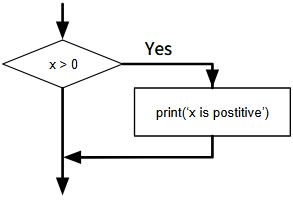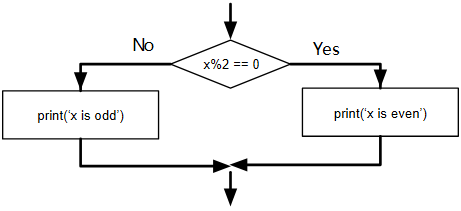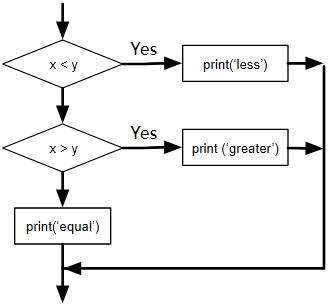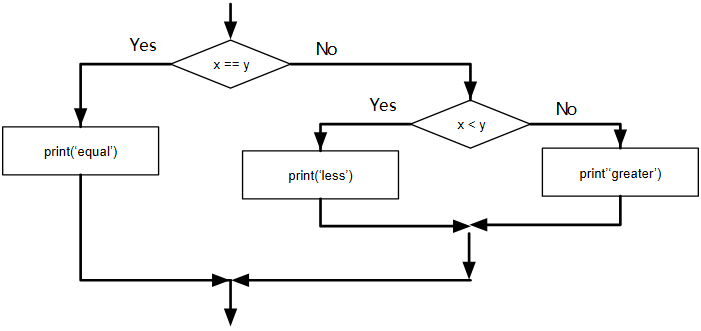Boolean expressions
A boolean expression is an expression that is either true or false. The following examples use the operator ==, which compares two operands and produces True if they equal and False otherwise:
>>> 5 == 5
True
>>> 5 == 6
FalseTrue and False are special values that belong to the class bool; they are not strings:
>>> type(True)
<class 'bool'>
>>> type(False)
<class 'bool'>The == is one of the comparison operators; the others are:
x != y # x is not equal to y
x > y # x is greater than y
x < y # x is less than y
x >= y # x is greater than or equal to y
x <= y # x is less than or equal to y
x is y # x is the same as y
x is not y # x is not the same as yAlthough these operations are probably familiar to you, the Python symbols are different from the mathematical symbols for the same operations. A common error is to use a single equal sign (=) instead of a double equal sign (==).
Remember that = is an assignment operator and == is a comparison operator. There is no such thing as =< or =>.
Logical operators
There are three logical operators: and, or, not. The semantics (meaning) of these operator is similiar to their meaning in English. For example,
x > 0 and x < 10
is true only if x is greater than 0 and less than 10.
n%2 == 0 or n%3 ==0 is true only if either of the conditions is true, that is, if the numeber is divisible by 2 or 3.
Finally, the not operator negates a boolean expression, so not (x > y) is ture if x > y is false.
>>> x = 1
>>> y = 2
>>> x > y
False
>>> not (x > y)
TureStrictly speaking, operands of the logical operators should be boolean expressions, but Python is not very strict. Any nonzero numbers is interpreted as "ture".
>>> 17 and Ture
>>> TureThis flexibility can be useful in some situations, but there are some subtleties to it that might be confusing. You might to avoid it until you are sure you know what you are doing.
Conditional execution
In order to write useful programs, we almost always need the ability to check conditions and change the behavior of program accordingly. Conditional statements give us this ability. The simplest form is if statement:
if x > 0:
print('x is positive')The boolean expression after the if statement is called the condition. We end the if statement with a colon character (:) and the line(s) after the if statement are indented.

If Logic
If the logical condition is true, then the indented statement gets executed. If the logical condition is false, the indented statement is skipped.
if statements have the same structure as function definitions or for loops. The statement consists of a header line that ends with the colon character (:) followed by an indented block. Statements like this are called compound statements because they stretch across more than one line.
if x > y:
print(x)
print(y)There is no limit on the number of statement that can appear in the body, but there must be at least one. Occasionally, it is useful to have a body with no statements (usually as a place holder for code you haven't written yet). In this case, you can use the pass statement to pass the Python interpreter check, which does nothing.
if x < 0 :
pass # need to handle negative values, do nothing for now.If you enter an if statement in the Python interpreter, the prompt will change from three chevrons (>>>) to three dots (...) to indicate you are in the middle of a block of statements, as shown below:
>>> x = 3
>>> if x < 10:
... print('Small')
...
Small
>>>When using the Python interpreter, you must leave a blank line at the end of a block, otherwise Python will return an error:
>>> x = 3
>>> if x < 10:
... print('Small')
... print('Done')
File "<stdin>", line 3
print('Done')
^
SyntaxError: invalid syntaxA blank line at the end of a block of statements is not necessary when writing and executing a script, but it may improve readability of your code.
Alternative execution
A second form of the if statement is alternative execution, in which there are two possibilities and the condition determines which one gets executed. The syntax looks like this:
if x % 2 == 0:
print('x is even')
else:
print('x is odd')If the remainder when x is divided by 2 is 0, then we know that x is even, and the program displays a message to that effect. If the condition is false, the second set of statements is executed.

If-Then-Else Logic
Since the condition must either true or false, exactly one of the alternatives will be executed. The alternatives are called branches, because they are branches in the flow of execution.
Chained conditionals
Sometimes there more than two possibilities and we need more than two branches. One way to express a computation like that is a chained conditional:
if x < y:
print('x is less than y')
elif x > y:
print('x is greater than y')
else:
print('x and y are equal')elif is an abbreviation of "else if." Again, exactly one branch will be executed.

If-Then-ElseIf Logic
There is no limit on the number of elif statements. If there is an else clause, it has to be at the end, but there doesn't have to be one.
if choice == 'a':
print('Bad guess')
elif choice == 'b':
print('Good guess')
elif choice == 'c':
print('Close, but not correct')Each condition is checked in order. If the first is false, the next is checked, and so on. If one of them is true, the corresponding branch executes, and the statement ends. Even if more than one condition is true, only the first true branch executes.
Nested conditionals
One conditional can also be nested within another. We could have written three-branch example like this:
if x == y:
print('x and y are equal')
else:
if x < y:
print('x is less than y')
else:
print('x is greater than y')The outer conditional contains two branches. The first branch contains a simple statements. The second branch contains another if statement, which has two branches of its own. Those two branches are both simple statements, although they could have been conditional statements as well.

Nested If Statements
Although the indentation of the statements makes the structure apparent, nested conditional become difficult to read very quickly. In general, it is a good idea to avoid them when you can.
Logical operators often provide a way to simplify nested conditional statements. For example, we can rewrite the following code using a single conditional:
if 0 < x:
if x < 10:
print('x is a positive single-digit number.')The print statements is executed only when we pass both conditionals. We can get the same effect with the and operator:
if 0 < x and x < 10:
print('x is a positive single-digit number.')Catching exceptions using try and except
Earlier we saw a code segment where we used the input and int functions to read and parse an integer number entered by the user. We also saw how treacherous doing this could be:
>>> prompt = "What is the air velocity of an unladen swallow?\n"
>>> speed = input(prompt)
What is the air velocity of an unladen swallow?
What do you mean, an African or a European swallow?
>>> int(speed)
ValueError: invalid literal for int() with
base 10: 'What do you mean, an African or a European swallow?'
>>>When we are executing these statements in the Python interpreter, we get a new prompt from the interpreter, think "oops", and move on to our next statements.
However if you place this code in a Python script and this error accurs, your script immediately stops in its tracks with a traceback. It does not execute the following statements.
Here is a sample program to convert a Fahrenheit temperature to a Celsius temperature:
inp = input('Enter Fahrenheit Temperature:')
try:
fahr = float(inp)
cel = (fahr - 32.0) * 5.0 / 9.0
print(cel)
except:
print('Please enter a number')Python starts by executing the sequence of statements in the try block. If all goes well, it skips the except block and proceeds. If an exception occurs in the try block, Python jumps out of the try block and excecutes the sequence of statements in the except block.
Enter Fahrenheit Temperature:72
22.22222222222222
Enter Fahrenheit Temperature:fred
Please enter a numberHandling an exception with a try statement is called catching an exception. In this example, the except clause prints an error message. In general, catching an exception gives you a chance to fix the problem, or try again, or at least end the program gracefully.
Short-circuit evaluation of lagical expressionos
When python is processing a logical expression such as x > 2 and (x/y) >2, it evaluates the expression from left to right. Because of the definition of and, if x is less than 2, the expression x >= 2 is False and so the whole expression is False regardless of whether (x/y) > 2 evaluates to Ture or False.
When Python dectects that there is nothing to be gained by evaluating the rest of a logical expression, it stops its evaluation and does not do the computations in the rest of the logical expression. When the evaluation of a logical expression stops because the overall value is already known, it is called short-circuit the evaluation.
While this may seem like a fine point, the short-circuit behavior leads to a clever technique called guardian patten. Consider the following code sequence in the Python interpreter:
>>> x = 6
>>> y = 2
>>> x >= 2 and (x/y) > 2
True
>>> x = 1
>>> y = 0
>>> x >= 2 and (x/y) > 2
False
>>> x = 6
>>> y = 0
>>> x >= 2 and (x/y) > 2
Traceback (most recent call last):
File "<stdin>", line 1, in <module>
ZeroDivisionError: division by zero
>>>The third calculation failed because Python was evaluating (x/y) and y was zero, which causes a runtime error. But the first and the second examples dit not fail because in the first calculation y was non zero and in the second one the first part of these expressions x >= 2 evaluated to False so the (x/y) was not ever executed due to the short-circuit rule and there was no error.
We can construct the logical expression to strategically place a guard evaluation just before the evaluation that might cause an error as follow:
>>> x = 1
>>> y = 0
>>> x >= 2 and y != 0 and (x/y) > 2
False
>>> x = 6
>>> y = 0
>>> x >= 2 and y != 0 and (x/y) > 2
False
>>> x >= 2 and (x/y) > 2 and y != 0
Traceback (most recent call last):
File "<stdin>", line 1, in <module>
ZeroDivisionError: division by zero
>>>In the first logical expression, x >= 2 is False so the evaluation stops at the and. In the second logical expression, x >= 2 is Ture but y != 0 is False so we never reach (x/y).
In the third logical expression, the y != 0 is after the (x/y) calculation so the expression fails with an error.
In the second expression, we say that y != 0 acts as a guard to insure that we only execute (x/y) if y is non-zero.
Debugging
The traceback Python displays when an error occurs contains a lot of information, but it can be overwhelming. The most useful parts are usually:
- What kind of error it was, and
- Where it occured.
Syntax errors are usually easy to find, but there are a few gotchas. Whitespace errors can be tricky because spaces and tabs are invisible and we are used to ignoring them.
>>> x = 5
>>> y = 6
File "<stdin>", line 1
y = 6
^
IndentationError: unexpected indentIn this example, the problem is that the second line is indented by one space. But the error message points to y, which is misleading. In general, error messages indicate where the problem was discovered, but the actual error might be earlier in the code, sometimes on a previous line.
In general, error messages tell you where problem was discovered, but that is often not where it was caused.
Glossary
body
The sequence of statements within a compound statements.
boolean expression
An expression whose value is either Ture or False.
branch
One of the alternative sequences of statements in a conditional statement.
chained conditional
A conditional statement with with a series of alternative branches.
comparison operator
One of the operators that compares its operands: ==, !=, >, <, >=, and <=.
conditional statement
A statement that controls the flow of execution depending on some condition.
condition
The boolean expression in a conditional statement that determines which branch is executed.
compound statement
A statement than consists of a header and a body. The header ends with a colon (:). The body is indented relative to the header.
gardian patten
Where we construct a logical expression with additional comparisons to take advantage of the short-circuit behavior.
logical operator
One of the operators that combines boolean expressions: and, or, and not.
nested conditional
A conditional statement that appears in one of the branches of another conditional statement.
traceback
A list of functions that are executing, printed when an excetion occurs.
short-circuit
When Python is part-away through evaluating a logical expression and stops the evaluation because Python knows the final value for the expression without needing to evaluate the rest of the expression.
Exercises
Exercise 1: Rewrite your pay computation to give the employee 1.5 times the hourly rate for hours worked above 40 hours.
hours = float(input('Enter Hours: '))
rate = float(input('Enter Rate: '))
if hours > 40:
print('Pay: ', hours * rate + (hours - 40) * rate * 0.5)
else:
print('Pay: ', hours * rate)Enter Hours: 45
Enter Rate: 10
Pay: 475.0Excercise 2: Rewrite you pay program using try and except so that your program handles non-numeric input gracefully by printing a message and exiting the program. The following shows two executions of the program.
Enter Hours: 20
Enter Rate: nine
Error, please enter numeric input
Enter Hours: forty
Error, please enter numeric inputtry:
inp = input('Enter Hours: ')
hours = float(inp)
inp = float(input('Enter Rate: '))
rate = float(inp)
if hours > 40:
print('Pay: ', hours * rate + (hours - 40) * rate * 0.5)
else:
print('Pay: ', hours * rate)
except:
print('Error, please enter numeric input')Excercise 3: Write a program to prompt for a score between 0.0 and 1.0. If the score is out of range, print an error message. If the score is between 0.0 and 1.0, print a grade using the following table:
Score Grade
>= 0.9 A
>= 0.8 B
>= 0.7 C
>= 0.6 D
< 0.6 Finp = input('Enter score: ')
try:
score = float(inp)
except:
score = -1
if score < 0 or score > 1:
print('Bad score')
elif score >= 0.9:
print('A')
elif score >= 0.8:
print('B')
elif score >= 0.7:
print('C')
elif score >= 0.6:
print('D')
else:
print('F')Enter score: 0.95
A
Enter score: perfect
Bad score
Enter score: 10.0
Bad score
Enter score: 0.75
C
Enter score: 0.5
FRun the program repeatedly as shown above to test the various different values for input.
留言